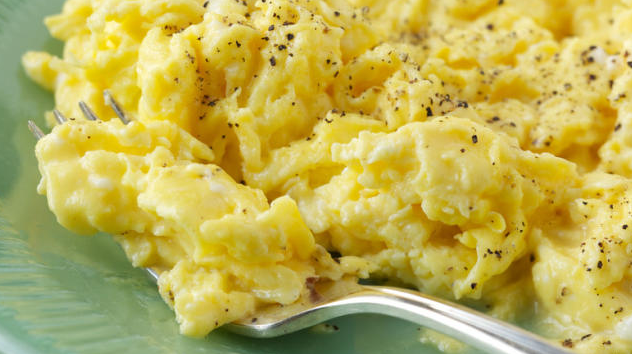
When it comes to scrambled eggs, one of the most hotly debated topics is whether or not to add milk. What might seem like a simple decision can spark passionate discussions among cooks, with some swearing by the creaminess milk provides, while others firmly believe it ruins the natural flavor and texture of the eggs. Even professional chefs have differing opinions, and it’s likely that your family does, too. So, who’s right? Should you add milk to scrambled eggs, or is it best left out?

The Argument for Adding Milk
For many, milk is the secret to creating soft, creamy, and fluffy scrambled eggs. Here’s why advocates of this method swear by it:
– Creamier Texture Milk brings in extra moisture, leading to a smoother and creamier texture. If you’re someone who loves your scrambled eggs light and silky, milk can help you achieve that melt-in-your-mouth experience. It’s especially useful for those who prefer their eggs less dense and more velvety.
– Balanced Flavor Eggs are naturally rich, and for some, that can be overwhelming. Adding milk can help balance this out by muting some of that richness. With a splash of milk, you might notice a more mellow, rounded flavor. Some people even report a subtle sweetness, especially when using whole milk or cream.
– Stretching the Dish Milk is an easy way to increase the volume of your scrambled eggs without adding more eggs. When you’re cooking for a crowd, this trick can help you stretch your ingredients while still delivering fluffy eggs. It’s a clever solution for making a small number of eggs go further.
The Argument Against Adding Milk
On the flip side, traditionalists and purists argue that milk detracts from the natural beauty of scrambled eggs. They claim that milk dilutes the flavor and can even affect the texture negatively. Here’s why they skip the milk:
– Diluted Egg Flavor Eggs have a distinct, savory taste that many people love. Milk can dull this flavor, leaving you with blander eggs. If you’re someone who prefers the unaltered taste of eggs, adding milk might feel like it’s taking away from their natural goodness.
– Texture Issues While milk can sometimes lead to creamier eggs, it can also make them rubbery if overcooked. The extra liquid from milk can be difficult to control, leading to uneven cooking. Some parts might end up runnier, while others can become tough or dry. The result is often a scramble that lacks consistency.
– Unnecessary Ingredient Many cooks believe that high-quality eggs, a bit of butter, and seasoning are all you need for the perfect scramble. For these purists, the simplicity of just eggs, butter, and salt allows the natural flavors to shine, making milk unnecessary. Why mess with something that’s already delicious?
Alternatives to Milk in Scrambled Eggs
If you’re not sold on milk but still want to elevate your scrambled eggs, there are other ingredients you can try:
– Cream or Half-and-Half Instead of milk, try using cream or half-and-half for a richer scramble. With its higher fat content, cream adds luxurious texture without watering down the flavor. You’ll still get that silkiness, but with a deeper taste.
– Butter Adding butter while whisking the eggs or as they cook is another way to enhance both flavor and texture. Butter melts into the eggs, creating a smooth consistency without the need for milk.
– Cheese If you’re looking for an extra layer of creaminess, cheese is a fantastic option. A sprinkle of cheddar, feta, or even cream cheese will not only enhance the texture but also infuse your eggs with savory richness.
How to Make Fluffy Scrambled Eggs Without Milk
For those who prefer their scrambled eggs without milk, there’s a simple method to achieve perfectly fluffy eggs. Here’s how:
– Whisk Your Eggs Thoroughly Aeration is key to fluffy scrambled eggs. Whisk your eggs vigorously to incorporate air, which will naturally give them a light texture without any milk.
– Cook on Low Heat Eggs cooked on low heat are less likely to become tough or rubbery. Low and slow cooking allows the eggs to form soft curds without drying out.
– Add Butter or Oil Melt a tablespoon of butter or oil in your pan before adding the eggs. This will prevent sticking and contribute to that smooth, creamy texture you’re after.
– Stir Gently Gently stir your eggs as they cook to form tender curds. Be careful not to over-stir, as that can lead to smaller, denser pieces.
The Final Verdict: Milk or No Milk?
In the end, the choice of whether or not to add milk to scrambled eggs boils down to personal preference. If you love the creaminess and volume milk brings, then it’s worth trying. But if you prefer the natural, rich flavor of eggs, you might want to skip it. Experiment with both methods to see which one suits your taste best.
After all, the beauty of cooking is its flexibility. There’s no one “right” way to make scrambled eggs—only the way that makes you happiest when you sit down to eat. Whether you’re on team milk or team no milk, what matters most is that you enjoy the meal you’ve made.
















